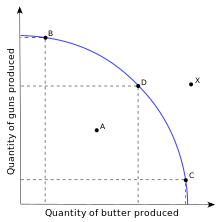GDP
GDP (Gross Domestic Product): Total value of all final goods & services produced w/in a country's borders in a given year.- Includes all production or income earned w/in the US by US and foreign producers.
- Excludes production outside of the US, even by Americans.
GDP Formula= C + Ig + G + Xn
C: Consumption (67%)
Ig: Gross Private Domestic Investment (18%)
- Factor equipment maintenance
- New factor equipment
- Construction of housing
- Unsold inventory of products built in a year
G: Government purchases (17%)
Xn: Net Exports (Exports-Imports) (-2%)
Included in GDP:
- C
- Ig
- G
- Xn
Excluded in GDP:
- Intermediate goods -Avoid double or multiple counting
- Used or secondhand- Avoid double or multiple counting
- Stocks & Bonds- No production
- Unreported business activity (Ex: Tips)
- Gifts/Transfer Payments(Public/Private)- Ex: Scholarship, social security, unemployment
- Illegal activities
- Non-market activities- Ex: Volunteering, Babysitting
GNP
- Includes production or income earned by Americans anywhere in the world.
- Excludes production by non-Americans, even in the US.
GNP Formula:
GDP + Net Foreign Factor Payment





